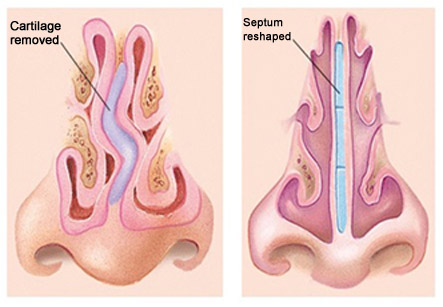Septoplasty
Introduction
Septoplasty is a surgical procedure to correct the shape of the septum of the nose. The goal of this procedure is to correct defects or deformities of nasal septum. The nasal septum is the separation between the two nostrils and this septum is composed partly of cartilage and partly of bone. Septal deviations may either be congenital (present since birth) or acquired as a result of an injury. Most people with deviated septum do not suffer from any symptoms. However, when the septum is severely deformed, it produces significant symptoms and requires surgical correction.
Most of the septoplasties are usually performed during rhinoplasty procedures done for cosmetic purposes. Polypectomy, ethmoidectomy, removal of tumors, and turbinate surgical procedures often involve septoplasty. Individuals who have addiction of sniffing significant quantities of cocaine often require septoplasty because of alterations in the nasal passage structures.
During septoplasty, your nasal septum is straightened and repositioned in the middle of your nose

The nasal septum has three functions:
1. Supporting the nose
2. Regulation of air flow
3. Supporting the mucous membranes (mucosa) of the nose.
Symptoms:
Septal deviations or deformities cause nasal airway obstruction. It can cause symptoms such as:
1. Mouth breathing
2. Chronic nasal infections
3. Obstructive sleep apnea
4. Headache due to septal spurs
The primary conditions that may suggest a need for septoplasty include:
1. Nasal airway obstruction
2. Deformity of nasal septum
3. Headaches caused by septal bony spurs
4. Chronic and uncontrolled nosebleeds
5. Chronic sinusitis due to deviated septum
6. Obstructive sleep apnea
7. Polyp removal
8. Tumor excision
9. Turbinate surgery
10. Ethmoidectomy surgery
Procedure:
Most patients receive general anesthesia before septoplasty. This means the patient is asleep and pain-free during the procedure. Some doctors may even perform this surgery under local anesthesia, which numbs the area to block pain. Surgery takes about 1 to 1 ½ hours and patients usually go home the same day.
The surgeon makes an incision inside the wall on one side of the nose.
After this, the mucus membrane that covers the wall is lifted up.
Then the surgeon removes or moves any cartilage or bone that is causing the blockage in the area.
After this, the mucus membrane is put back in place. This membrane is then held in place by stitches, splints, or packing material.
Diagnosis:
Septal deviation is usually diagnosed by direct observation of the nasal passages by ENT surgeon. In addition, a computed tomography (CT) scan of the entire nasal cavity can be ordered. This scan allows the physician to fully assess the structures and functioning of the area. Additional tests for evaluation of the movement of air through the nasal passages may also be performed.
Patients are usually sent home from the hospital later the same day or rarely in the morning after the surgery.
Before performing a septoplasty, the difference in airflow between the two nostrils must be demonstrated. In children, this assessment can be done very simply by asking the child to breathe out slowly on a small mirror or a metal plate held in front of the nose.
Preparation:
If a general anesthetic is used, then the patient is advised not to eat or drink after midnight the night before the surgery. In many cases, septoplasty is performed as an outpatient procedure under local anesthesia. Conditions in which patient is not advised to receive a septoplasty include excessive cocaine abuse, Wegener’s granulomatos is, malignant lymphomas, and a very large septal perforation.
Aftercare
Patients are usually sent home from the hospital later the same day or rarely in the morning after the surgery. All dressings inside the nose are removed before the patient leaves.
The head needs to be elevated during the first 24-48 hours after surgery. Breathing through the mouth is required while the nasal packing is still in place. A small amount of bloody discharge is normal after surgery. Some patients may have severe pain, which may require narcotic pain relievers. Patients are often advised to place an ice pack on the nose for comfort during the recovery period. Patients who have splint placement in the nose usually return after 7 to 10 days of the surgery for examination and splint removal.
Risks
The risks of septoplasty are similar to those from other operations on the face:
1. Postoperative pain
2. Bleeding
3. Local swelling and bruising
4. Infection, which is uncommon
5. Allergic reactions to the anesthetics.
6. A cerebrospinal fluid leak which is extremely rare but a serious complication. This can be treated with proper nasal packing, bed rest, and antibiotic use.
7. Need for follow-up surgery in case of relapse of nasal obstruction
Results
Normally, there is improved breathing and airflow through the nostrils after surgery, and an acceptable outward shape of the nose. Most patients have significant improvements in symptoms following surgery.